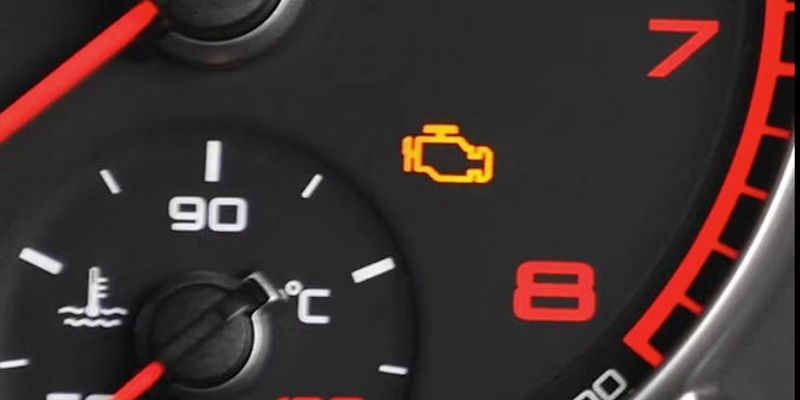This post contains affiliate links. This means I will make a commission at no extra cost to you should you click through and make a purchase [ “As an Amazon Associate, I earn from qualifying purchases.” ]. Read the full disclosure here.
Mercedes Yellow Engine Warning Light GuideMechanic.Com Mercedes vehicles are known for their exceptional performance and cutting-edge technology. However, like any other car, they can experience issues from time to time.
One common concern that Mercedes owners may encounter is the yellow engine warning light. This article will provide you with a comprehensive guide on understanding this warning light, its possible causes, and the steps you can take to address the issue.
Before we delve into the details, it’s important to note that the yellow engine warning light, also known as the check engine light, should never be ignored.
While it may not always indicate a severe problem, it serves as an early warning system that something is amiss with your Mercedes. Ignoring it could potentially lead to further damage and expensive repairs.
What Does the Yellow Engine Warning Light Mean?

The yellow engine warning light is a crucial indicator that something is not functioning optimally within your Mercedes. When this light illuminates on your dashboard, it is typically accompanied by a sense of uncertainty and concern. Understanding the meaning behind this warning light is the first step in addressing the issue.
See Also: Mercedes Dashboard Symbols and Meanings
There are various possible causes for the yellow engine warning light to turn on. One common reason is a malfunctioning oxygen sensor.
The oxygen sensor plays a vital role in regulating the air-fuel mixture in the engine. When it fails, it can cause the engine to run inefficiently, resulting in reduced performance and increased emissions.
Another potential cause is a loose or faulty gas cap. A loose gas cap can lead to fuel vapors escaping, triggering the yellow engine warning light.
Other potential causes of the yellow engine warning light include a malfunctioning catalytic converter, a faulty mass airflow sensor, or a problem with the ignition system.
These issues can impact the overall performance and efficiency of your Mercedes. It’s essential to identify the specific cause of the warning light to determine the appropriate course of action.
The Role of Diagnostic Tools
Modern Mercedes vehicles are equipped with advanced diagnostic systems that can help identify the specific issue triggering the yellow engine warning light.
These systems, such as the Mercedes-Benz Diagnostic System (MBDS), utilize onboard sensors and computer algorithms to analyze data from various components of the vehicle.
By connecting a diagnostic tool to your Mercedes, you can retrieve error codes and access valuable information to pinpoint the underlying problem.
Diagnostic tools provide valuable insights into the health of your vehicle’s engine and enable you to make informed decisions regarding repairs or maintenance.
They can save you time and money by accurately diagnosing the issue, preventing unnecessary part replacements or repairs.
Mercedes Yellow Engine Warning Light: Addressing Minor Issues
Check out this Cal-Van Tools 72 Amp Hound 2, 1 Pack, Multi, One Size

Not all triggers of the yellow engine warning light indicate a severe problem. In some cases, the light may illuminate due to minor issues that can be easily resolved by Mercedes owners themselves.
By understanding these common minor issues and learning how to address them, you can potentially save yourself a trip to the mechanic.
Checking the Gas Cap
A loose or faulty gas cap is one of the simplest reasons for the yellow engine warning light to turn on. The fuel system in your Mercedes is designed to be a closed system, preventing fuel vapors from escaping into the atmosphere. A loose gas cap can disrupt this system and trigger the warning light.
See Also: Mercedes Dashboard Warning Lights Explained
To address this issue, start by turning off your engine. Then, locate the gas cap on the side of your vehicle. Ensure that it is tightly secured by turning it clockwise until you hear a clicking sound.
After securing the gas cap, start your engine and check if the yellow engine warning light remains illuminated. If the issue was indeed a loose gas cap, the light should turn off within a few driving cycles.
Replacing Faulty Spark Plugs
Spark plugs play a crucial role in the combustion process of your Mercedes’ engine. Over time, spark plugs can become worn out or fouled, causing misfires and reduced engine performance. Faulty spark plugs can trigger the yellow engine warning light.
To address this issue, you will need to locate the spark plugs in your Mercedes’ engine bay. Refer to your vehicle’s manual for the specific location and instructions on how to safely access them.
Start by disconnecting the spark plug wires and removing the old spark plugs using an appropriate socket wrench. Inspect the condition of the spark plugs, looking for signs of wear, damage, or carbon buildup.
If necessary, replace the old spark plugs with new ones, ensuring that they are properly gapped according to your vehicle’s specifications.
Reconnect the spark plug wires, ensuring they are securely attached. Once the spark plugs have been replaced, start your engine and check if the yellow engine warning light persists.
Mercedes Yellow Engine Warning Light: Intermediate Fixes and Maintenance
In some cases, the yellow engine warning light may indicate more significant issues that require a bit more expertise or the assistance of a professional.
While it’s always recommended to consult with a qualified mechanic for complex problems, there are some intermediate fixes and maintenance tasks that you can perform to address certain issues.
Addressing a Faulty Mass Airflow Sensor
The mass airflow sensor (MAF) is responsible for measuring the amount of air entering the engine. This information is crucial for achieving the correct air-fuel mixture, ensuring optimal engine performance. A faulty MAF sensor can cause the yellow engine warning light to turn on and lead to decreased power and fuel efficiency.
To address this issue, you may need to clean or replace the MAF sensor. Start by locating the MAF sensor, which is typically positioned between the air filter box and the intake manifold.
Carefully disconnect the electrical connector from the sensor. Depending on the type of MAF sensor in your Mercedes, you may need to unscrew it from the intake manifold or air filter box.
If cleaning is recommended for your specific MAF sensor, use a specialized MAF sensor cleaner to remove any dirt or debris. If cleaning does not resolve the issue, it may be necessary to replace the MAF sensor with a new one.
Ensure that the new sensor is compatible with your Mercedes model and follow the manufacturer’s instructions for installation.
Dealing with a Faulty Ignition Coil
The ignition system in your Mercedes is responsible for generating the spark necessary for combustion. The ignition coil plays a vital role in this process, converting the battery’s low voltage into the high voltage required to create a spark. A faulty ignition coil can lead to misfires, rough idling, and the illumination of the yellow engine warning light.
Replacing a faulty ignition coil requires some mechanical knowledge and tools. Start by identifying the location of the ignition coil in your Mercedes’ engine bay.
Refer to your vehicle’s manual for specific instructions on accessing and removing the ignition coil. Disconnect the electrical connector and any mounting bolts securing the ignition coil.
Carefully remove the old ignition coil and replace it with a new one that is compatible with your Mercedes model. Ensure that the new ignition coil is securely fastened and reconnect the electrical connector. Start your engine and check if the yellow engine warning light remains illuminated.
Preventive Measures to Avoid Yellow Engine Warning Light

While it’s important to know how to address the yellow engine warning light, it’s equally crucial to adopt preventive measures to minimize the likelihood of encountering this issue. By practicing regular maintenance and proactive care, you can reduce the chances of triggering the yellow engine warning light.
Adhere to Regular Maintenance Schedule
Following the manufacturer’s recommended maintenance schedule is essential for keeping your Mercedes in optimal condition.
Regular oil changes, fluid checks, and filter replacements help ensure that your engine runs smoothly and efficiently. Neglecting routine maintenance can lead to issues that may trigger the yellow engine warning light.
Monitor Fluid Levels and Quality
Fluids such as engine oil, coolant, and transmission fluid play critical roles in safeguarding the performance and longevity of your Mercedes.
Regularly check these fluid levels and monitor their quality. Low or contaminated fluids can lead to engine overheating, component damage, and ultimately trigger the yellow engine warning light.
Use Quality Fuel and Additives
Using high-quality fuel and additives can help maintain the cleanliness of your engine and prevent issues that may trigger the yellow engine warning light. Quality fuel ensures proper combustion and minimizes the risk of fuel system problems.
Additionally, using reputable fuel additives, such as fuel system cleaners, can help keep your fuel injectors and other components clean, reducing the likelihood of performance issues.
Mercedes Yellow Engine Warning Light: Debunking Myths and Misconceptions
When it comes to the yellow engine warning light, there are several myths and misconceptions that can confuse car owners. It’s essential to separate fact from fiction to make informed decisions regarding your Mercedes. Let’s debunk some of the common myths associated with the yellow engine warning light.
Myth: The Yellow Engine Warning Light Always Indicates a Major Problem
Contrary to popular belief, the yellow engine warning light does not always indicate a major problem. While it’s true that some triggers may require immediate attention, others may be related to minor issues that can be easily resolved. It’s crucial to properly diagnose the specific cause of the warning light before jumping to conclusions.
Myth: Disconnecting the Car Battery Resets the Yellow Engine Warning Light
Disconnecting the car battery may temporarily turn off the yellow engine warning light, but it does not address the underlying problem.
See Also: Mercedes Sprinter Warning Lights
The warning light is designed to reappear if the issue persists. Disconnecting the battery only clears the stored error codes, making it more challenging to diagnose the actual problem.
Myth: You Can Pass Emissions Tests with the Yellow Engine Warning Light On
Having the yellow engine warning light illuminated on your dashboard typically means there is an issue with your vehicle’s emission control system.
In most states and countries, passing emissions tests with the warning light on is not possible. It’s best to address the issue causing the warning light before attempting an emissions test.
Mercedes Yellow Engine Warning Light: The Importance of Regular Maintenance
Maintaining a regular maintenance schedule is crucial for the overall health and performance of your Mercedes. By staying on top of routine inspections and servicing, you can prevent issues that may trigger the yellow engine warning light.
Routine Inspections and Fluid Checks
Regular inspections of your Mercedes’ engine bay, including checking for loose hoses, leaks, or worn-out belts, can help identify potential problems before they escalate.
Additionally, monitoring fluid levels and quality, such as engine oil, coolant, and brake fluid, is essential for preventing issues that may trigger the yellow engine warning light.
Timely Servicing and Filter Replacements
Following the manufacturer’s recommended service intervals ensures that vital components, such as air filters, fuel filters, and spark plugs, are replaced at the appropriate times. Neglecting these routine replacements can lead to performance issues and potential triggers of the yellow engine warning light.
Proactive Care for Emission Control System
The emission control system in your Mercedes plays a crucial role in minimizing harmful pollutants from being released into the environment.
Regularly inspecting and maintaining components such as the oxygen sensor, catalytic converter, and exhaust system can help prevent issues that may trigger the yellow engine warning light related to emissions.
The Role of Advanced Vehicle Systems
Modern Mercedes models come equipped with advanced vehicle systems that can provide more detailed information about the yellow engine warning light. These systems utilize innovative technologies to enhance the diagnostic process and assist in resolving issues effectively.
The Mercedes-Benz Diagnostic System (MBDS)
The Mercedes-Benz Diagnostic System (MBDS) is a specialized tool designed to communicate with the onboard computer systems in your Mercedes.
By connecting the MBDS to your vehicle, you can retrieve error codes and access real-time data related to various components. This information helps pinpoint the specific cause of the yellow engine warning light and facilitates accurate diagnosis and repair.
Onboard Vehicle Monitoring Systems
Modern Mercedes vehicles are equipped with onboard vehicle monitoring systems that constantly monitor various parameters and components.
These systems can detect abnormalities and trigger the yellow engine warning light to notify you of potential issues. By understanding how to interpret the information provided by these systems, you can gain valuable insights into your Mercedes’ health and take appropriate action.
Related video of Understanding the Mercedes Yellow Engine Warning Light: Causes, Fixes, and More
- Project Trucks for Sale Cheap - July 1, 2025
- Salvage Title Trucks for Sale - July 1, 2025
- Restored Classic Trucks for Sale - July 1, 2025

